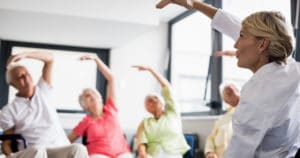
As one ages, aches and pains become a common occurrence. However, there are instances where these pains can be a symptom of underlying health problems. For this reason, managing aches and pains have become a challenge for geriatric medical practitioners. Those with advanced age often complain of arthritis, cancer, and other diseases associated with pain. According to an early study published in the Journal of American Geriatric Society, elderly individuals in senior care homes are more likely to experience pain.
One of the most effective ways of managing aches and pains in the elderly is knowing the common aches and pains that afflict the elderly. Here are some of them:
Low Back Pain
Low back pain is the most common complaint in America, even in the younger population. For those aged 50, the cause of pain is often due to prolonged sitting. For the elderly, the reason could be due to underlying health conditions such as arthritis. One common way of managing it is by doing strength and cardio exercises. It increases blood flow to core muscles that help support the spine. The elderly can also benefit from receiving physical therapy or chiropractic care as part of their health and wellness program. There are exercises and activities that they can do to relieve back pain and increase mobility.
Headaches and Migraines
Another one of the common complaints in the elderly is headaches and migraines. While its cause is still unknown, the triggers are easy to pinpoint. Stress, dehydration, weather changes, and some food items can trigger headaches. The elderly should manage them by avoiding triggers and using non-pharmacologic therapy as much as possible.
Osteoarthritis
As much as 33% of adults are suffering from osteoarthritis. That’s why this condition is often referred to as the illness of the elderly. Pain occurs because the cartilage that acts as a cushion between the joint and the bone wears out, which leads to friction, which causes pain. The key to easing the ache is maintaining an active lifestyle. Staying active helps your blood to circulate appropriately, thereby strengthening the muscles surrounding the joint, which removes the pressure on the bone and joint.
Carpal Tunnel Syndrome
Carpal tunnel syndrome occurs when the nerve that passes through the arm to your palm gets squeezed or pressed. This pressure causes pain on the wrist down to the fingers. It is commonly associated with numbness and a tingling sensation as well. Carpal tunnel syndrome is often due to doing repetitive actions such as constant typing or operating machinery. However, it can also have other causes, such as genetics and hormonal changes.
In severe cases, the best way of managing carpal tunnel syndrome is with surgery. If this is not an option for you, you might want to talk to your doctor about prescribing occupational rehabilitation therapy or pain relievers.
Muscular Strains
As you age, it is pretty standard for your muscles to become sore easily. This pain results from less dense muscle fibers. As your muscle fibers thin out, they become less flexible, resulting in a higher probability of getting sore muscles and injury even when doing activities that you commonly do. Muscular strains get worse as one ages. How do we avoid it? The best way is to avoid doing activities that make your muscles more vulnerable. As much as possible, do not lift and push heavy items. It would also help to engage in stretching exercises like yoga and Pilates.
Pelvic Pain
Pain in the pelvic area is more common in women, as it is often associated with endometriosis and irritable bowel system (IBS). For pelvic pain, doctors usually advise against waiting before it becomes too painful. Treatment options vary depending on the underlying cause of your pelvic pain, but they commonly include physical therapy and prescription medicines.
Managing Pain in the Elderly
The success of managing aches and pains in the senior population starts from getting a comprehensive pain assessment. Without it, medical practitioners would find conditions hard to diagnose, treat, and monitor. One of the crucial things to help you achieve success is by applying a consistent method for pain assessment. Consistency in measurement and evaluation allows you to get a better picture of whether your patient has pain that resolves following your treatment.
Final Thoughts
There are many considerations when it comes to managing sore muscles and joints and headaches. Medical practitioners should be aware of any possible underlying conditions before they proceed with their treatment programs to ensure that they are not doing more harm than good.